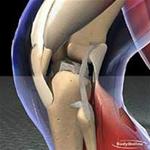How to identify and handle mismatches
A joint error is a normal loss of anatomy between the joints of the joints after a serious injury to the joint or limb, may also be due to congenital or pathological conditions.
Signs to identify false joints:
-
 Photos of knee anatomy (Photo: TTO) Pain due to joint injury.
Photos of knee anatomy (Photo: TTO) Pain due to joint injury.
- Reduce or completely lose motor function.
- The joint of the joint is hollow, this is a special sign of the joint. But not all joints have this symptom but only in the shoulder joint, jaw joint and part of the elbow joint. If the patient is late for treatment, it is difficult to see because the pain is swollen.
- Deformation of the whole limb: If the shoulder joint is wrong, the arm posture is deformed and cannot be closed close to the body. If the hip joint is wrong, the limb posture becomes short, the pillow rotates inward, the lateral foot has a false joint and rests on the side of the hindquarters.
- Abnormal signs of signs due to dislocation of the bone from the joint.
- Elastic movement, also called Spring sign, is only in the wrong joint because the bone head is dislocated and tightened in the tendon muscle and ligament. Whether intentionally pulling or pushing to bring the joint back to its normal position, the joint still returns to the wrong position.
In addition to the above typical signs, joints also have the following special distortion signs: Signs of shoulder humping (perpendicular shoulder) are often seen in the shoulder joint; signs of a faintness in the case of a rear elbow joint (due to a protruding elbow with the posture of the arm creating an inner recess like the stump of an unfinished ax); key sign of the piano found in the joint with shoulder - blow.
To solve
In many cases of joint mismatch, patients often ask others to try to pull back, but most of these people do not have expertise. As a result, the pain becomes even more painful and will be more difficult during treatment.
If in the process of labor, or in daily life, unfortunately you are wrong, to diagnose the injury properly, you need to go to the examination and screenings at the joint specialty. Because in many cases, injury not only leads to joint dislocation, but it can also stretch the ligaments, sprains, fractures or fractures.
For the elderly, this must be more cautious. If not treated promptly, it is likely that the cases of joints will lead to complications such as vascular compression, nervousness, open joints and batches of bones .
- How to handle when the car
- The first aid for burns
- Two Hong Kong students invented the self-sterilizing door handle, the team afraid of dirty like this
- 'Big family' technology helps to handle Japan disaster
- Can animals recognize them when looking at mirrors?
- How to handle when being stung by jellyfish and cramps during summer bathing
- 3 tips everyone should know when cooking
- How to handle when insects get into their ears
- Identify corpses by maggots
- How to handle when you encounter a bomb explosion
- The way of distinguishing the sugar from the chemical way
- How to deal with drug poisoning
 Green tea cleans teeth better than mouthwash?
Green tea cleans teeth better than mouthwash? Death kiss: This is why you should not let anyone kiss your baby's lips
Death kiss: This is why you should not let anyone kiss your baby's lips What is salmonellosis?
What is salmonellosis? Caution should be exercised when using aloe vera through eating and drinking
Caution should be exercised when using aloe vera through eating and drinking